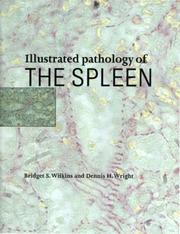| Listing 1 - 10 of 11 | << page >> |
Sort by
|
Book
ISBN: 1608052737 9781608052738 Year: 2011 Publisher: Hilversum, The Netherlands : Bentham Science Publishers,
Abstract | Keywords | Export | Availability | Bookmark
 Loading...
Loading...Choose an application
- Reference Manager
- EndNote
- RefWorks (Direct export to RefWorks)
The spleen is an organ responsible for many biological functions, such as immunological defense, the removal of foreign particles from the blood stream, the metabolism of bilirubins, lipids and several amino acids, the control of the number and maturity of blood leukocytes and platelets and haematopoesis. This book is a collection of medical methods written exclusively to show the spleen in relation to basic sciences (anatomy and physiology) and related clinical practice and is a useful resource for clinical physicians, haematologists, oncologists, general surgeons, and oncologic surgeons.

ISBN: 1107114934 051111687X 0511303254 0511545975 051105050X 1280153261 0511152485 9786610153268 0511019637 9780511019630 9780511050503 9780511116872 9780521622271 0521622271 6610153264 9781107114937 9780511303258 9780511545979 9781280153266 9780511152481 0521622271 Year: 2000 Publisher: Cambridge, UK ; New York, NY : Cambridge University Press,
Abstract | Keywords | Export | Availability | Bookmark
 Loading...
Loading...Choose an application
- Reference Manager
- EndNote
- RefWorks (Direct export to RefWorks)
The major aim of this book is to de-mystify splenic pathology for non-specialist consultants and trainees in histopathology. The interpretation of pathological changes in the human spleen provides a significant challenge to the skills of even the most highly trained histopathologists. This comprehensive account of the most important and frequently encountered pathological conditions affecting the spleen is highly illustrated in colour throughout with numerous detailed macroscopic and microscopic specimens. Emphasis is placed upon the importance of adequate clinical information and technical preparation of splenectomy specimens in obtaining the best possible histopathological assessment of the tissue. A systematic, analytical approach to interpretation of pathological changes is used throughout the book. This should enable readers to feel confident in their assessment of significant processes within the spleen. This volume serves as an illustrated atlas, a bench manual, as a text, and as a source of reference, and will be an indispensable guide.
Spleen --- Hematopoietic system --- Lymphoid tissue --- Histopathology.
Periodical
Abstract | Keywords | Export | Availability | Bookmark
 Loading...
Loading...Choose an application
- Reference Manager
- EndNote
- RefWorks (Direct export to RefWorks)
Hybridomas --- Monoclonal antibodies --- Antibodies, Monoclonal --- Hybridomas. --- Monoclonal antibodies. --- Monoclonal immunoglobulins --- Myeloma-spleen cell hybrids --- Biotechnology. --- Immunology. --- Medical Technology. --- Immunoglobulins --- Molecular cloning --- Clone cells --- Lymphocytes --- Plasmacytoma --- Somatic hybrids --- Agriculture Sciences --- Engineering --- Soil Chemistry, Microbiology, Fertility & Fertilizers --- Biotechnology

ISBN: 1280413654 9786610413652 3764374136 3764371730 Year: 2005 Publisher: Boston, MA : Birkhauser,
Abstract | Keywords | Export | Availability | Bookmark
 Loading...
Loading...Choose an application
- Reference Manager
- EndNote
- RefWorks (Direct export to RefWorks)
Georges Köhler (1946-1995) was one of the most prominent German scientists of recent history. In 1984, at an age of 38, he received the Nobel Prize in Physiology or Medicine, together with N.K. Jerne and C. Milstein, for inventing the technique for generating monoclonal antibodies. This method and its subsequent applications had an enormous impact on basic research, medicine and the biotech industry. In the same year, Köhler became one of the directors of the Max-Planck-Institute of Immunobiology in Freiburg; his unfortunate premature death in 1995 set an end to his extraordinary career. Prof. Klaus Eichmann, who had joined the institute as director in 1981, and had invited Köhler to become his codirector, is one of the people who were closest to Georges Köhler. This scientific biography commemorates the 10th anniversary of Köhler's untimely death. It describes his scientific and personal biography, based on 10 years of close personal and professional relationship between Eichmann and Köhler, as well as interviews with many colleagues and friends, including his "Doktorvater" and mentor Fritz Melchers. Köhler's scientific achievements are explained in a way to make them understandable for the general public and discussed in the historical context of the immunological research at the time.
Immunologists --- Hybridomas. --- Monoclonal antibodies. --- Köhler, Georges. --- Antibodies, Monoclonal --- Monoclonal immunoglobulins --- Immunoglobulins --- Molecular cloning --- Myeloma-spleen cell hybrids --- Clone cells --- Lymphocytes --- Monoclonal antibodies --- Plasmacytoma --- Somatic hybrids --- Immunology --- Medical scientists --- Immunology. --- Medicine. --- Biomedicine general. --- Clinical sciences --- Medical profession --- Human biology --- Life sciences --- Medical sciences --- Pathology --- Physicians --- Immunobiology --- Serology --- Health Workforce --- Biomedicine, general. --- Köhler, Georges --- Kohler, Georges.

ISBN: 0309064473 0309519047 0585082421 9780585082424 0309075114 9780309075114 0309173051 Year: 1999 Publisher: [Place of publication not identified] National Academies Press
Abstract | Keywords | Export | Availability | Bookmark
 Loading...
Loading...Choose an application
- Reference Manager
- EndNote
- RefWorks (Direct export to RefWorks)
MEDICAL --- Immunology --- Biology --- Health & Biological Sciences --- Microbiology & Immunology --- Monoclonal antibodies --- Hybridomas. --- Mice as laboratory animals. --- Synthesis --- Methodology. --- Myeloma-spleen cell hybrids --- Antibodies, Monoclonal --- Monoclonal immunoglobulins --- Laboratory animals --- Clone cells --- Lymphocytes --- Plasmacytoma --- Somatic hybrids --- Immunoglobulins --- Molecular cloning --- Therapeutic use. --- Hybridomas --- Mice as laboratory animals --- Methodology
Book
ISBN: 1461446716 1461446724 Year: 2013 Publisher: New York : Springer,
Abstract | Keywords | Export | Availability | Bookmark
 Loading...
Loading...Choose an application
- Reference Manager
- EndNote
- RefWorks (Direct export to RefWorks)
The spleen is an organ which has diverse functions including immunologic and hematologic. The Atlas of Spleen Pathology describes and selectively illustrates the normal and pathologic conditions that afflict the spleen. This extraordinary collection of high quality digital images will materially aid in continuing efforts to recognize, understand, and accurately interpret the gross and light microscopic findings in spleens.
Bone marrow -- Diseases. --- Histology, Pathological -- Atlases. --- Histology. --- Pathology -- Atlases. --- Lymphoid Tissue --- Tissues --- Lymphatic System --- Immune System --- Anatomy --- Hemic and Immune Systems --- Spleen --- Medicine --- Health & Biological Sciences --- Hematologic Diseases --- Pathology --- Diseases --- Medicine. --- Pathology. --- Medicine & Public Health. --- Disease (Pathology) --- Medical sciences --- Medicine, Preventive --- Clinical sciences --- Medical profession --- Human biology --- Life sciences --- Physicians --- Hematopoietic system --- Lymphoid tissue

ISBN: 0444805923 9780444805928 1281716170 9781281716170 9786611716172 6611716173 0080858821 9780080858821 0444805753 Year: 1986 Volume: 13 Publisher: Amsterdam: Elsevier,
Abstract | Keywords | Export | Availability | Bookmark
 Loading...
Loading...Choose an application
- Reference Manager
- EndNote
- RefWorks (Direct export to RefWorks)
This volume contains detailed, comprehensive advice on rat, mouse and human hybridoma production. It begins with a general introduction, then describes the practical applications of the technology with photographs and protocols for everything from animal dissection to epitope analysis of antigens.
Biological techniques --- Molecular biology --- Immunology. Immunopathology --- Biochemical engineering --- Biotechnology. --- Hybridomas. --- Monoclonal antibodies. --- Antibodies, Monoclonal. --- Immunologic Technics. --- Basic Sciences. Molecular Biology --- Molecular Biology (General). --- Biotechnology --- Hybridomas --- Monoclonal antibodies --- Antibodies, Monoclonal --- Immunologic Techniques --- Biochemistry --- Technique. --- Immunologie --- 57.083.3 --- Antibody Dissociation --- Immunologic Technic --- Immunologic Technics --- Immunologic Technique --- Immunological Technics --- Immunological Techniques --- Technic, Immunologic --- Technics, Immunologic --- Technique, Immunologic --- Techniques, Immunologic --- Antibody Dissociations --- Dissociation, Antibody --- Dissociations, Antibody --- Immunological Technic --- Immunological Technique --- Technic, Immunological --- Technics, Immunological --- Technique, Immunological --- Techniques, Immunological --- Allergy and Immunology --- Immunity --- Immunochemistry --- Myeloma-spleen cell hybrids --- Clone cells --- Lymphocytes --- Plasmacytoma --- Somatic hybrids --- 57.083.3 Immunological methods and techniques --- Immunological methods and techniques --- Monoclonal Antibodies --- Monoclonal Antibody --- Antibody, Monoclonal --- Monoclonal immunoglobulins --- Immunoglobulins --- Molecular cloning --- Chemical engineering --- Genetic engineering --- methods --- Antibodies, Monoclonal - laboratory manuals --- Hybridomas - laboratory manuals --- Hybridoma --- Interleukin-6
Book
Year: 2022 Publisher: Basel MDPI - Multidisciplinary Digital Publishing Institute
Abstract | Keywords | Export | Availability | Bookmark
 Loading...
Loading...Choose an application
- Reference Manager
- EndNote
- RefWorks (Direct export to RefWorks)
Image analysis can be applied to rich and assorted scenarios; therefore, the aim of this recent research field is not only to mimic the human vision system. Image analysis is the main methods that computers are using today, and there is body of knowledge that they will be able to manage in a totally unsupervised manner in future, thanks to their artificial intelligence. The articles published in the book clearly show such a future.
Newton-Raphson’s method --- chaos --- image encryption/decryption --- security analysis --- image encryption --- cryptanalysis --- hyper-chaotic --- ribonucleic acid --- color image encryption --- transformed Zigzag --- image segmentation --- computer-assisted diagnosis --- machine learning --- spleen injury detection --- hyperchaotic --- permutation --- diffusion --- multiple bit operation --- circular-step wedge --- contrast-detail --- mutual information --- visible ratio --- anode heel effect --- prior information --- entropy --- fwi --- regularization --- inverse problems --- bat optimization --- human crowd behavior (HCB) --- improved entropy (IE) --- Jaccard similarity --- multi-person counting --- particles gradient motion (PGM) --- speeded up robust features (SURF) --- Retinex --- image enhancement --- gamma correction --- low-light image --- HSV color space --- scan route --- Hilbert curve --- run-length-based entropy coding --- image and video compression --- secure communication --- cellular neural network --- power-divergence measure --- computed tomography --- iterative reconstruction --- maximum-likelihood expectation-maximization method --- continuous-time image reconstruction --- n/a --- Newton-Raphson's method
Book
Year: 2021 Publisher: Basel, Switzerland MDPI - Multidisciplinary Digital Publishing Institute
Abstract | Keywords | Export | Availability | Bookmark
 Loading...
Loading...Choose an application
- Reference Manager
- EndNote
- RefWorks (Direct export to RefWorks)
Extracellular vesicles (EVs) are particles wrapped in a lipid bilayer membrane and are naturally released from cells. This kind of cargo vessel is a nanostructure that mainly transfers lipids, proteins, various nucleic acid fragments, and metabolic components to neighboring cells or distant parts of the body through the circulatory system. EVs are of great significance to the communication mechanism between cells. This book collects feature articles to enhance our understanding of the biological characteristics of EVs and their potential applications.
extracellular vesicle --- precision oncology --- cancer biomarker --- prostate cancer --- drug delivery --- extracellular vesicles --- lysosome --- nanocarriers --- ultrasound --- size exclusion chromatography --- differential ultracentrifugation --- head and neck squamous cell carcinoma (HNSCC) --- exosomes --- cancer --- biomarker --- diagnostic --- therapy --- liquid biopsy --- small extracellular vesicles (sEV) --- tumor-derived exosomes (TEX) --- melanoma cell-derived exosomes (MTEX) --- proteomics --- tumor microenvironment --- biomarkers --- ectosomes --- neoplasia --- microvesicles --- small extracellular vesicles --- isolation --- purification --- size-exclusion chromatography --- ultracentrifugation --- sucrose density cushion --- lymph node --- spleen --- solid tissue --- microvesicle --- exosome --- cancer therapeutic --- drug carrier --- flow cytometry --- immunophenotyping --- swarm detection --- tumor-associated macrophages --- macrophage polarization --- mannose receptor --- HIV-1 Nef --- glioblastoma --- microRNA --- immunoprecipitation --- CD44 --- human milk --- nutrient --- microbiota --- microRNAs --- nanocommunicator --- diagnostic biomarker --- drug delivery vehicle --- personalized cancer immunotherapy --- therapeutic agents --- cell-to-cell communication --- ionising radiation --- non-targeted effects --- signalling --- imaging flow cytometry --- biomarker reservoirs --- cancer diagnostics --- disease monitoring --- large EVs --- ovarian cancer cells --- ES-2 --- OAW-42 --- adipose tissue origin mesenchymal stem cells --- n/a
Book
ISBN: 3030377083 3030377075 Year: 2020 Publisher: Cham : Springer International Publishing : Imprint: Springer,
Abstract | Keywords | Export | Availability | Bookmark
 Loading...
Loading...Choose an application
- Reference Manager
- EndNote
- RefWorks (Direct export to RefWorks)
This book provides a comprehensive and up-to-date overview of the pathologic features of common benign and malignant hematopoietic disorders in spleen and liver for practicing pathologists, hematopathologists and clinicians. The authors are from large academic centers, affiliated teaching hospitals and central referral clinics and are experienced in the diagnosis of hematopoietic disorders in the spleen and liver. The book consists of 21 chapters, with the first three chapters devoted to normal histologic features, conventional, cytogenetic and molecular studies necessary for the diagnosis of hematopoietic disorders in the spleen and liver. Chapters 4 to 17 cover the primary and secondary mature B- and T/NK cell lymphomas, Hodgkin lymphoma, B and T cell lymphoblastic leukemias, myeloid neoplasms, histiocytic and dendritic neoplasms, and post-transplant disorders including post transplant lymphoproliferative disorders. Chapters 19 to 21 encompass red blood cell disorders, other benign hematologic disorders and infectious/inflammatory disorders that could mimic hematopoietic neoplasms. These chapters are formatted on specific hematopoietic neoplasms to comprise epidemiology, etiology, pathogenesis, morphology, immunophenotyping, molecular genetics, prognosis and brief treatment guidelines. Diagnostic caveats are included in order to have a quick review of the key points in each chapter. Diagnostic Pathology of Hematopoietic Disorders of Spleen and Liver covers most, if not all of the benign and malignant hematopoietic disorders in the spleen and liver and serves as a practical and useful resource for general pathologists and hematopathologists.
Hematopoietic system. --- Hemopoietic system --- Hematopoiesis --- Hematopoietic System. --- Leukemia. --- Lymphoma. --- Neoplasms, Plasma Cell. --- Liver Diseases. --- Spleen. --- Hematopoietic Systems --- System, Hematopoietic --- Liver Dysfunction --- Disease, Liver --- Diseases, Liver --- Dysfunction, Liver --- Dysfunctions, Liver --- Liver Disease --- Liver Dysfunctions --- Plasma Cell Neoplasms --- Neoplasm, Plasma Cell --- Plasma Cell Neoplasm --- Germinoblastoma --- Lymphoma, Malignant --- Reticulolymphosarcoma --- Sarcoma, Germinoblastic --- Germinoblastic Sarcoma --- Germinoblastic Sarcomas --- Germinoblastomas --- Lymphomas --- Lymphomas, Malignant --- Malignant Lymphoma --- Malignant Lymphomas --- Reticulolymphosarcomas --- Sarcomas, Germinoblastic --- Lymphatic Diseases --- Hematologic Neoplasms --- Leucocythaemia --- Leucocythemia --- Leucocythaemias --- Leucocythemias --- Leukemias --- Myeloproliferative Disorders --- Pathology. --- Hematology. --- Oncology . --- Oncology. --- Tumors --- Haematology --- Internal medicine --- Blood --- Disease (Pathology) --- Medical sciences --- Diseases --- Medicine --- Medicine, Preventive --- Malalties hematològiques --- Malalties del sistema limfàtic --- Melsa --- Fetge --- Diagnòstic. --- Oncologia --- Medicina --- Oncologia geriàtrica --- Oncologia pediàtrica --- Oncologia veterinària --- Càncer --- Infermeria oncològica --- Diagnosi --- Diagnòstic físic --- Examen mèdic (Diagnòstic) --- Exploració médica (Diagnòstic) --- Exploració clínica (Diagnòstic) --- Medicina clínica --- Cateterisme --- Cribratge --- Diagnòstic d'infermeria --- Diagnòstic diferencial --- Diagnòstic dual --- Diagnòstic molecular --- Diagnòstic prenatal --- Diagnòstic quirúrgic --- Diagnòstic per la imatge --- Electrodiagnòstic --- Entrevista clínica --- Examen físic --- Isòtops radioactius en diagnòstic mèdic --- Monitoratge de pacients --- Proves funcionals (Medicina) --- Patologia --- Pronòstic mèdic --- Símptomes --- Abdomen --- Aparell digestiu --- Tracte biliar --- Cèl·lules hepàtiques --- Bilis --- Cirurgia hepàtica --- Hepatologia --- Sistema limfàtic --- Elefantiasi --- Limfomes --- Malalties de la sang --- Malalties sanguínies --- Malalties --- Anèmia --- Eosinofília --- Mononucleosi --- Septicèmia --- Trastorns de les plaquetes sanguínies --- Hematologia
| Listing 1 - 10 of 11 | << page >> |
Sort by
|

 Search
Search Feedback
Feedback About UniCat
About UniCat  Help
Help News
News